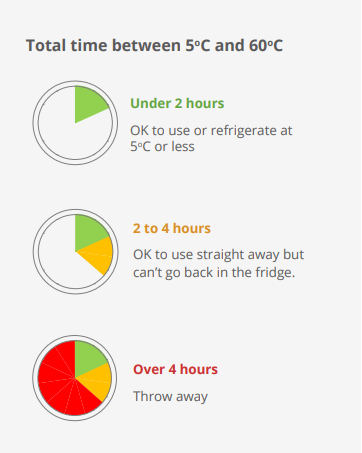Potentially hazardous food should be stored, displayed, and transported under temperature control, either below 5 degrees celsius or above 60 degrees celsius. However, some food businesses, may choose to use another method of temperature control.
One other method of temperature control is called the 2 hour / 4 hour rule. To make sure food poisoning bacteria do not grow in food, the food business must apply the 2 hour / 4 hour rule properly.
If you use the 2 hour / 4 hour rule in your food business you must keep written records showing how long the potentially hazardous food has been out of temperature control. See an example 2 hour/4 hour rule template.
2 hour / 4 hour rule guide
The 2 hour / 4 hour rule prescribes how long potentially hazardous food can be outside of temperature control. The timeframes below relate to the total time a particular food is outside of temperature control including time during preparation, storage, display and transport.
Under two hours
Food must be used or placed back under temperature control (5 degrees celsius or less or 60 degrees celsius or greater).
Two to four hours
Food must be used immediately - it cannot be re-refrigerated.
Four plus hours
Food must be discarded - it may have harmful levels of bacteria.
Total time between 5 degrees celsius and 60 degrees celsius:
- under 2 hours - okay to use or refrigerate at 5 degrees celsius or less
- 2 to 4 hours - okay to use straight away but can't go back in the fridge
- over 4 hours - throw away.

Example 1
A food business wants to display chicken and ham sandwiches in a non-refrigerated display cabinet during the busy lunch time period. To do this they apply the 2 hour / 4 hour rule.
- The food business must ensure that the chicken and ham has been kept under 5 degrees celsius before they receive it. Use a supplier that can provide written advice that the products have been kept below 5 degrees celsius during manufacture and transport to the food premises.
- To be safe, the food business should also carry out temperature checks of the food on arrival at the food business and record these temperatures.
- On arrival the products should be immediately put in the fridge and any time they are not in the fridge, the temperature and time out of the fridge must be recorded.
- The time taken to make up the sandwiches must be recorded, as this is time that the food is not being kept below 5 degrees celsius .
- The sandwiches can then be displayed in the non-refrigerated cabinet for the remaining period of time according to the 2 hour / 4 hour rule.
- For example, if the chicken and ham had been kept in the refridgerator until delivery at the premises, then left for thirty minutes before being placed in the cool room, then removed from the cool room to make the sandwiches, taking another thirty minutes. The chicken and ham have been outside of the fridge for a total of one hour. There is only a further one hour before the sandwiches can be either used or refrigerated, a further one to three hours before they must be used or a further three hours before they are to be discarded.
- If an environmental health officer arrives at the premises to do an inspection, the food business must be able to provide written records showing how long the sandwiches have been outside of the fridge. The food business must also be aware of what action to take once the time limits have expired.
Example 2
Using the 2 hour / 4 hour rule for food that has been previously cooked and cooled.
The 2 hour / 4 hour rule may be used where food has been cooked and cooled in line with the Food Safety Standards. For example, after cooking rice it is then allowed to cool from 60 degrees celsius to 21 degrees celsius within two hours and then from 21 degrees celsius to 5 degrees celsius within a further four hours. Then when the rice undergoes further processing, it may then be held outside of temperature control in line with the 2 hour / 4 hour rule.
To be safe it is best to always store and display food under temperature control and if in doubt, do not sell food you suspect may be contaminated or that may have been subjected to temperature abuse.